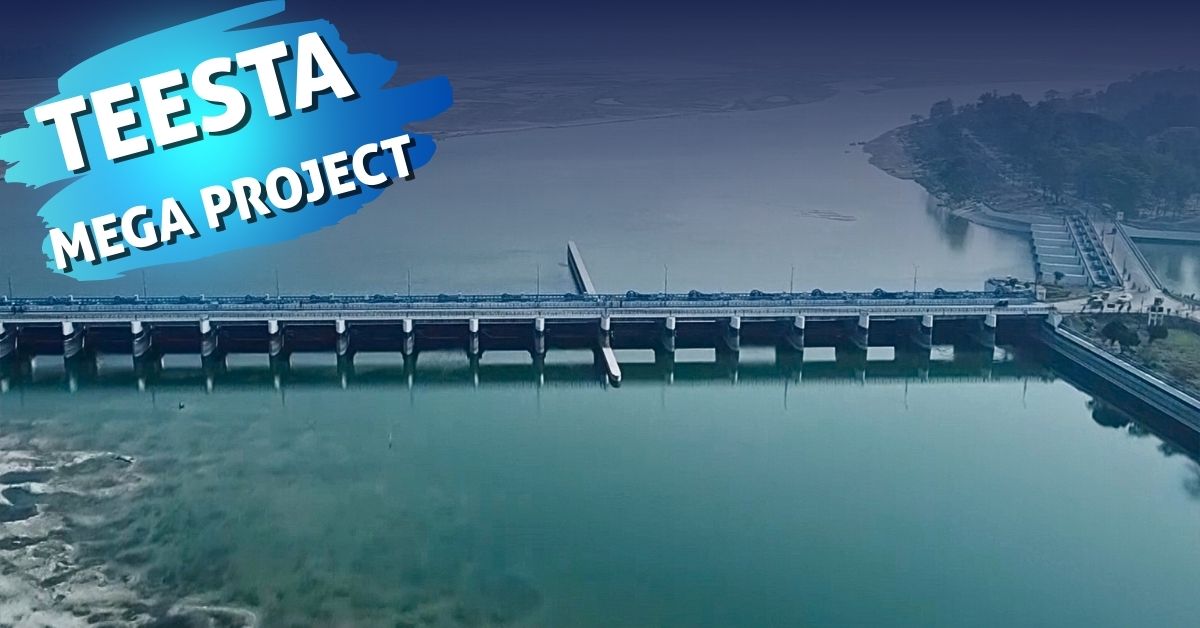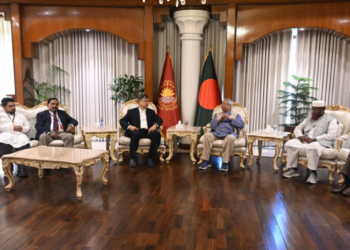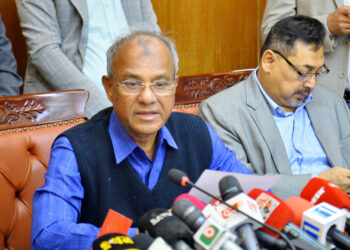1.Introduction
The Teesta Mega Project is a huge, multidimensional endeavor of the Government of Bangladesh for the overall development of the northern region of the country. The region, comprising Rangpur, Nilphamari, and Dinajpur districts, has an agricultural economy based primarily on seasonal monsoon rains. The ultimate objective of the project is to establish a consistent, perennial source of water for irrigation to hugely increase the productivity of agriculture and the living standard of the population of the region.
Teesta Mega Project has long-term implications for the reduction of poverty, economic development, as well as the national food security of the country, corresponding to its immediate agricultural objective. The project also has complex geopolitical dimensions, primarily related to the division of water of the Teesta River with the adjacent country, India. Introduction shall give a background spatial outline of the project, its environment, and overall aims.
The Teesta River, an important transboundary river, originates in the eastern Himalayas and passes through Indian states of Sikkim and West Bengal before entering Bangladesh. The river is an important element of agricultural and economic life in the states through which the river passes.
The river discharge, nevertheless, is very seasonal, with a heavy supply of water during the rainy season of the monsoon and very little water during the dry season. The seasonality of water supply has, in the process, constrained agricultural output in northern parts of Bangladesh, where farmers had traditionally been dependent on the rainy season’s monsoon rains for cultivation.
The Teesta Mega Project is intended to overcome this primal barrier by constructing the facilities and infrastructure that would help to manage and utilize the water resources of the river more efficiently. The project includes a range of components, including the construction of irrigation canals, barrages, and other water management facilities. Apart from its irrigation drive, the project aims to improve flood control, avert river erosion, and potentially generate hydroelectric power.
The Teesta Mega Project’s completion would bring unprecedented effects to the northern region of Bangladesh, revolutionizing the agricultural economy of the region, triggering economic development, and improving the living of millions of people. The project, however, is riddled with unprecedented problems, including astronomical expenses, technical complexity, and the contentious act of transboundary water sharing.
Read More: BUBT Career Fair 2025: Bridging Dreams with Opportunities
2. Background and Context
The economic value of the Teesta River to the citizens of India and Bangladesh has made its water a topic of perennial discussion, and at times, debate, among the two nations. The river’s catchment has a vast population that depends on the river for agriculture, fish, and other economic activities. The seasonality of the discharge of the river has brought about water management problems, particularly in the downstream part of the river in Bangladesh, as the shortage of water during the dry season can substantially impact agricultural production.
There have been a number of proposals, schemes, and treaties during the decades since the issue of water sharing with Bangladesh, but none long-term and comprehensive. Upstream water management schemes including barrages and dams in India have also complicated the issue, affecting the water flow into Bangladesh.
The Teesta Mega Project in Bangladesh is conceived in the backdrop of water scarcity, water management needs, and the complexity of sharing transboundary water. The project is an important endeavor of the Bangladeshi government to utilize its water resources and enhance agricultural output in the face of these limitations. The project is in consonance with the country’s overall development targets, including the alleviation of poverty, food security, and sustainable economic growth.
3. Major Economic Aims
The Teesta Mega Project is based on a set of overall economic aims that play a role in fulfilling the overall function of supporting sustainable development and human welfare in the northern region of Bangladesh. The aims relate to each other and are intended to eliminate the main bottlenecks to the economy in the region.
3.1 Irrigation Expansion
One of the main aims of the Teesta Mega Project is to greatly enhance the area of arable lands under irrigation. The project aims to bring under secure irrigation as much as 750,000 hectares of land, a vast enhancement compared to the current levels.
An enhancement in the coverage of irrigation is required to reduce the dependence of agriculture on seasonal rains and to achieve an assured availability of water throughout the year. Through the provision of a supply of water that is reliable to the farmers, the project aims to enable them to utilize their lands more intensely and to increase their overall agricultural output. An enhancement in the coverage of irrigation is also expected to enable the cultivation of a greater variety of crops, including water-intensive crops.
3.2 Agricultural Growth
The Teesta Mega Project will initiate intense agricultural development in the northern region of Bangladesh. The current reliance on the annual monsoon rains limits the farmers to a single or a double crop season. Under ensured irrigation, the project will enable the farmers to switch to multiples of cropping patterns with the prospect of three and even four crops a year.
Cropping intensification will lead to a spectacular rise in agricultural production, thereby contributing to local and national food security. The project also aims to enable the application of modern agricultural technology and the cultivation of high-value crops, capable of raising farm income and economic growth.
3.3 Rural Employment
The project would generate massive employment, both direct and indirect. Construction of the project would require a massive labor force, with direct employment to skilled and unskilled labor. Once the project is completed, it would generate long-term employment in agriculture as increased agricultural production would require increased labor in cultivation, harvesting, and post-harvesting activities.
The project would, in turn, give a boost to the allied industry and services, such as agricultural processing, transport, and marketing, leading to additional indirect employment. Generation of employment in the countryside is one of the prime aims of the project since it would reduce poverty, arrest rural-urban migration, and bring about inclusive economic growth.
3.4 Food Security
Food security in Bangladesh is one of the main aims of the Teesta Mega Project. The project aims to increase the production of staple food crops such as rice and wheat, the production of which is integral to the satisfaction of the country’s food needs. By providing a secure water source for agriculture, the project aims to stabilize crop yields and reduce the chances of crop loss from drought or water scarcity.
In addition to stimulating the production of staple food, the project aims to stimulate the cultivation of vegetables and other cash crops from the production of which farmers can accrue additional income and increase the variety of food diets available to them. The food security function of the project is integral to the alleviation of poverty, the enhancement of nutrition, and the stimulation of overall economic stability in the nation.

4. Project Elements
The Teesta Mega Project consists of some major components that will help in achieving its aims. These include:
Construction and Rehabilitation of Irrigation Infrastructure involves the new construction of canals, the rehabilitation of existing canals, as well as the barrages and other water control structures that allow for proper water distribution.
River training and flood control measures: Steps to control the flow of the Teesta River, reduce riverbank erosion, and reduce the chances of flooding.
Land reclamation: Land reclaimed from the river by dredging and other means to utilize in agriculture and other uses.
Infrastructure development: Construction of roads, highways, and other infrastructure to increase connectivity and facilitate agricultural activity.
Farmer Support Services: Providing farmers with training, a source of inputs, and other services in efforts to improve productivity levels.
5. Economic Benefits
The Teesta Mega Project would yield numerous economic advantages, changing the face of the agricultural sector as also that of the overall regional economy.
5.1 Agricultural Productivity
The project will maximize the agricultural potential of the area. Agriculture is currently highly reliant on the monsoon rains, and farmers are restricted to one or two crop seasons annually. As the farmers will be given guaranteed irrigation, they can use their lands from start to finish of the year, with the possibility of three to four crop seasons. The higher cropping intensity, coupled with the use of modern agricultural technologies, is anticipated to boost the production of crops by 30-40%. The higher productivity will accrue to the income of the farmers, the food security of the region, and the nation.
5.2 Local economy stimulus
The Teesta Mega Project will spur the development of the local economy. The increased crop production will lead to the development of agri businesses, i.e., cold storages, food processing, transport services, etc. The project also contemplates the development of opportunities for the development of micro-enterprises in agriculture, i.e., supply of irrigation equipment, fertilizers, etc. The project is also likely to enhance the value of lands in the irrigated area as the assured availability of water would make the land more valuable as well as productive.
5.3 Job Creation
The project will generate both short- and long-term employment opportunities. During the construction phase, a massive workforce would be employed, offering temporary employment to both skilled and unskilled workers. As the project is completed, the project would generate long-term employment in agriculture, water management, and related industries. The increased agricultural production would require additional labor for cultivation, harvesting, and processing. The growth of agri businesses and related services would generate additional employment opportunities.
5.4. Enhanced Liveliness
Increased agricultural productivity and the creation of new jobs will considerably improve the standard of living of the region’s people. The farmers will be able to earn more from increased production, and the rural communities will enjoy more reliable sources of income. This will lead to a decrease in the levels of poverty and better living conditions.
Read More: Grameenphone: A Vision Beyond Connectivity
6. Long-term strategic economic implications
The Teesta Mega Project would have a long-term strategic economic impact for the nation in the forthcoming years.
6.1 Poverty Reduction
The project will contribute towards poverty alleviation through increased incomes in agriculture and the creation of job opportunities. Increased improvement in the productivity of agriculture will allow farmers to obtain more income from their land, and the creation of new jobs in agriculture and allied activities will provide income opportunities to the rural poor. Poverty will be reduced and the overall economic well-being of the area will be improved.
6.2 food security
The project shall enhance food security in Bangladesh by increasing the yields of the most important food crops such as rice and wheat. The project’s assured irrigation shall maintain crop output and reduce the chances of crop loss from drought or water limitations. This shall keep the country’s food supply adequate to meet the needs of the growing population.
6.3 Economic Growth
The Teesta Mega Project will contribute to the overall development of the economy of Bangladesh. The increased agricultural production will improve the GDP of the country, and the development of the allied industry and services will further stimulate the economic activity. The project is also likely to assist the trade balance of the country by reducing the food imports and potentially increase the exports of agricultural commodities.
7. Environmental Impact
Although the Teesta Mega Project can potentially accrue huge economic returns, its potential environmental implications need to be studied. Large-scale water management can affect the environment in several ways, and careful planning and mitigation measures need to be initiated to minimize negative effects.
7.1 Changes in River Hydrology
Developmental activities such as barrages, canals, and other constructions can alter the natural trend of the Teesta River. The alteration may alter water flow patterns, loads of sediment, and river morphology. Environmental impact assessments need to be done carefully to identify the likely alterations and implement measures to maintain the ecological balance of the river.
7.2 effect on aquatic ecosystems
The alterations of river hydrology can have extensive implications for aquatic ecosystems. Modified stream regimes can alter fish spawning, fish migration, and habitat. Fish ladders, environmental flows, and habitat restoration must be incorporated into the project as aquatic biodiversity protection and conservation measures.
7.3 Water Quality
Increased agricultural activity can lead to increased use of fertilizers and pesticides, causing water pollution. The project needs to stimulate adoption of sustainable agricultural practices as well as water quality monitoring and maintenance.
7.4 Land Use Changes
The project can involve land reclamation and the alteration of the pattern of land use. These impact natural habitats, soil erosion, and overall health of ecosystems. Land use needs to be planned such that negative environmental impacts are minimized and desirable ecosystems are retained.
8. Social Impact
Teesta Mega Project shall have widespread social impacts in the project area’s population. These may be positive or negative and their management is required so that the project can be made useful to all the members of the project area community.
8.1 Displacement and Reset
Infrastructure development can require the relocation of some communities. Proper arrangements need to be made for reasonable and transparent resettlement so that the affected persons are given proper compensation and help to reestablish their lives.
8.2 Impact on Livelihood
The project will have a huge impact on the livelihood of the farmers and other people who use the river as a source of livelihood. Despite the fact that the project aims to increase agricultural productivity and offer new economic opportunities, caution must be exercised so as not to harm vulnerable communities.
8.3 Social Equity
It is important to ensure that the project benefits accrue to every person in the community. This entails ensuring that the marginalized groups and the small-scale farmers get adequate access to water, inputs, as well as other amenities.
8.4 Public Health
The water availability and agricultural change can lead to public health effects. Prevention of the spread of waterborne disease and public health and sanitation development must be incorporated into the project.
9. Challenges and Risks
The Teesta Mega Project faces numerous challenges and hazards that can affect its successful completion and long-term viability.
9.1 High Initial Cost
The project requires an enormous amount of money, which can potentially over expand the budget of the government. Proper control of the project’s budget and assurance that money is spent transparently and in an efficient manner is necessary.
9.2 Technical Problems
The construction and operation of the project infrastructure involve daunting technical complexities. Experienced engineers and technicians who can design, build, and maintain the project facilities are required.
9.3. Maintenance and Sustainability
Long-term sustainability and upkeep of the project infrastructure pose a massive challenge. The project must possess a robust management system and adequate finances for frequent upkeep and maintenance.
9.4 Governance and Corruption
Poor governance and corruption can undermine the success of the project and lead to inefficient use of resources. Strong governance arrangements, transparent procurement procedures, and sound monitoring and evaluation mechanisms need to be in place.
9.5 Climate Change
Climate change poses a major threat to the sustainability of the project in the long term. Changes in the patterns of precipitation, increased extreme event frequencies, and a rise in sea levels can potentially affect water availability and the operation of the project infrastructure.
9.6 Trans boundary Water Issues
The River Teesta is a trans boundary river, and sharing its water resources is a politically and controversial issue with India and Bangladesh. Any one-sided development project of the river can be controversial and affect the bilateral relationship of the two countries. Equitable sharing of the water of the river is very important to the long-term viability of the Teesta Mega Project.
10. Trans boundary Water Sharing
The trans boundary sharing of water is the central theme of the Teesta Mega Project. The Teesta River flows from India to Bangladesh, and the availability of water in Bangladesh is heavily dependent upon the utilization and control of water in the Indian upper catchment.
10.1 Current Situation
India and Bangladesh do not possess a holistic Teesta River water sharing treaty yet. A lack of such a treaty has resulted in uncertainty and tension in the availability of the water, particularly in the dry season when the water flows are low.
10.2 Upstream Impact
The construction of dams, barrages, and irrigation works in India has reduced the discharge of the Teesta River, causing damages to the downstream users in Bangladesh. The issue has generated water scarcity problem and its impact on agriculture and livelihood in Bangladesh.
10.3 Need for a Water-Sharing Treaty
It is important to the long-term viability of the Teesta Mega Project that a fair and just water-sharing deal is made among Bangladesh and India. The deal should be such that the needs of both the countries are considered and the water resources of the river are developed in a sustainable and equally beneficial manner.
10.4 Potential Solutions
A number of solutions have been proposed to resolve the issue of water sharing, including:
Joint Management: Creating a joint authority or a commission to manage the water resources of the river.
Water-Sharing Formula: Creating a formula for water sharing based on historical use, existing demands, and environmental factors.
Sharing of Information: Periodic sharing of data and information regarding availability of water, river discharge, and proposed development projects.
A Basin-Wide Approach: A holistic, Basin-wide approach to water management that takes into account the interest of all stakeholders.
11. Conclusion and Recommendations
The Teesta Mega Project can transform the agriculture sector, apart from triggering economic growth in the northern region of Bangladesh. As a source of assured water supply for agriculture, the project can increase agricultural output, create jobs, and reduce levels of poverty. The project, of course, also faces many challenges, including its huge price tag, technical complexity, environmental as well as social problems, and the politically charged subject of trans boundary sharing of water.
To make the project a success and achieve all its benefits, the following are suggested:
Preference should be given to Sustainable Water Management: Establish water-saving irrigation practices, encourage sustainable agriculture, and establish robust water management institutions.
Implement Environmental and Social Safeguards: Conduct comprehensive environmental and social impact assessments, establish measures to mitigate, resettle, and satisfactorily and appropriately compensate affected communities.
Promote Good Governance and Transparency: Ensure transparent procurement procedures, have in place effective monitoring and evaluation systems, and make project information available to all stakeholders.
Negotiate first a water-sharing arrangement in an equitable and balanced manner with India, based on principles of international water law and reciprocity.
Establish Local Capacity: Fund education and training initiatives to improve the capacity of water management professionals, farmers, and the local community to manage water more efficiently.
Be Inclusive: All stakeholders, including the private sector, local communities, farmers, and civil society groups, must be involved in the design, implementation, and monitoring of the project.
Implement an integrated monitoring system to monitor and evaluate the economic, social, and environmental project impacts, and utilize the learning to inform adaptive management and to determine that the project objectives are attained. In doing so, Bangladesh can maximize the full potential of the Teesta Mega Project to achieve its development objective, improve the welfare of its people, and achieve sustainable economic development in the country’s north.
Reference
Business inspection BD
The Financial Express


















